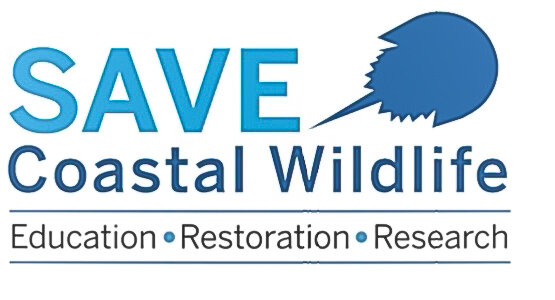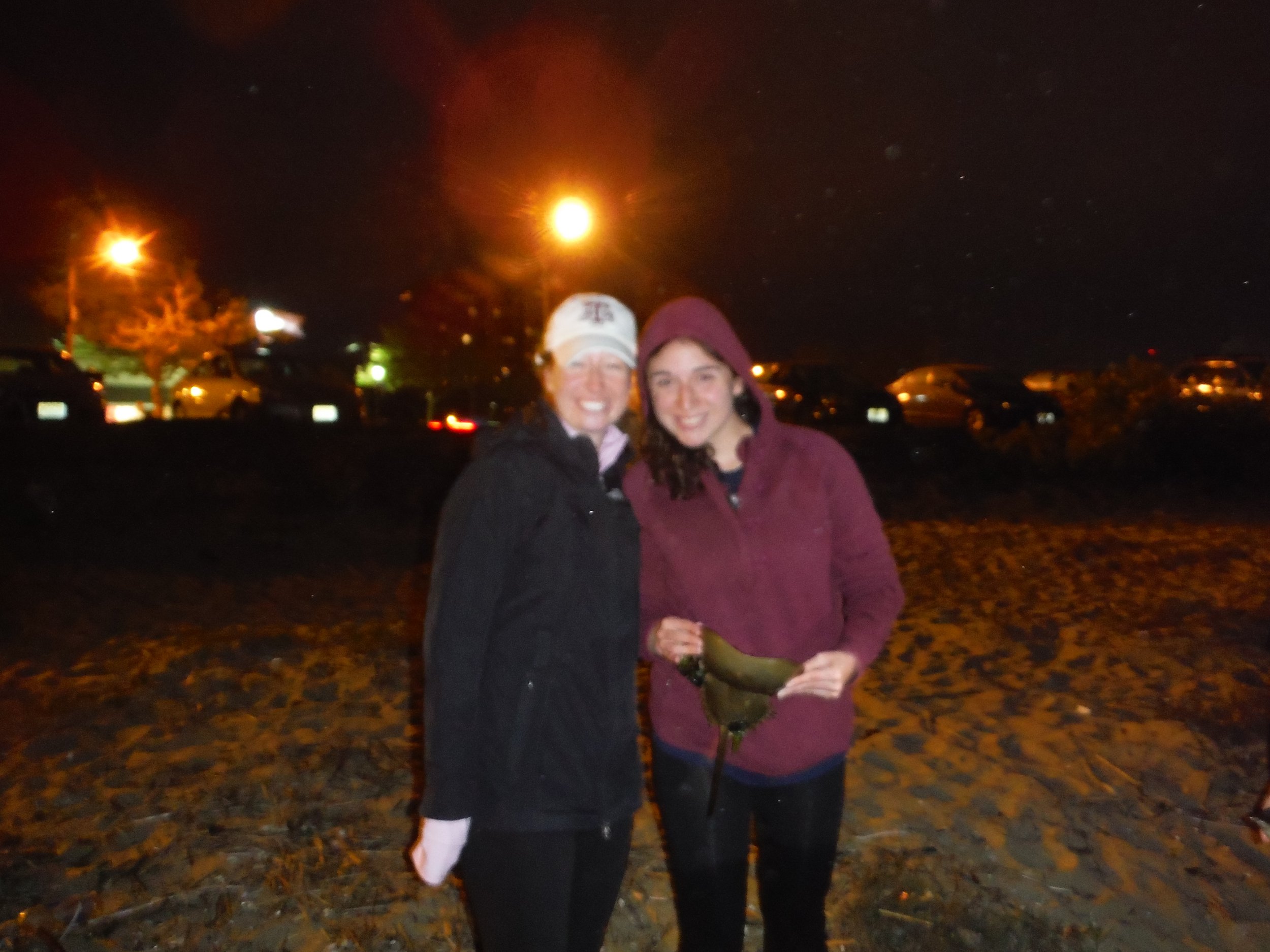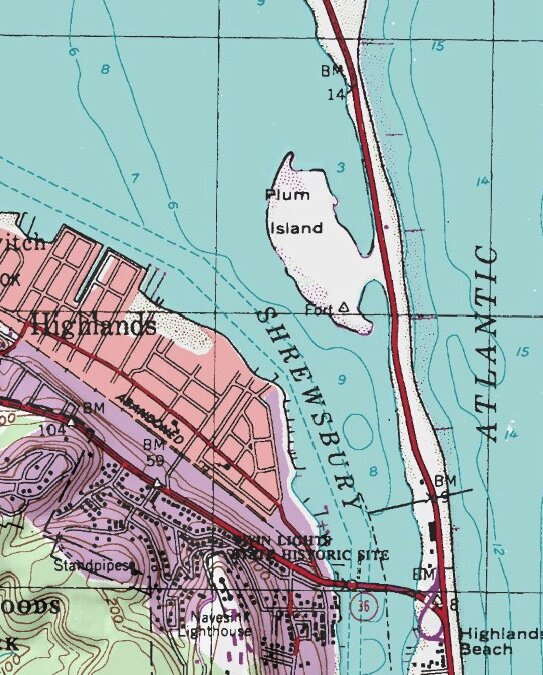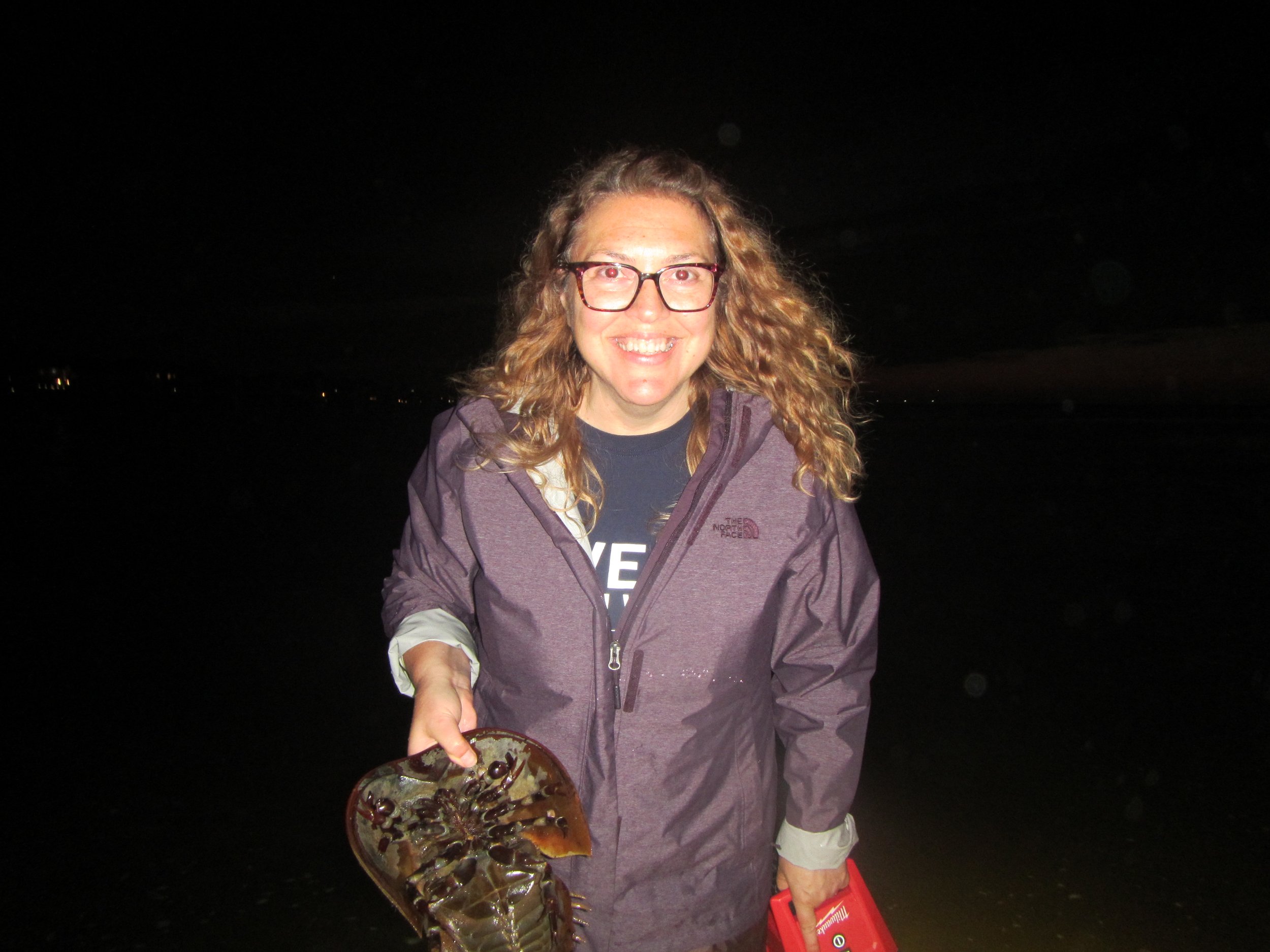Horseshoe Crab Monitoring
American or Atlantic Horseshoe Crab
(Limulus polyphemus)
Join volunteers with Save Coastal Wildlife (SCW) Nonprofit to help Collect Valuable Data on Horseshoe Crab Populations along the shores of Raritan Bay and Sandy Hook Bay, NJ.
Video by Gavin Shwahla: www.gavinwild.com
Since 2009, volunteers with Save Coastal Wildlife have been monitoring the spawning activity of horseshoe crab along the northern Jersey Shore.
Volunteers walk a bayside beach at several sites during the same time on full moon and new moon evenings in May & June to count the number of crabs present. Volunteers also tag single male and female crabs to keep track of their whereabouts and movements within New York - New Jersey Harbor Estuary as part of our ongoing efforts to understand the the mysterious life of a 400 million+ old species, an ancient mariner on this Blue Planet.
It’s exciting work that is contributing to long-term research and helping people better understand and protect horseshoe crabs, especially those that live in urban-suburban waters along the east coast of the United States.
Save Coastal Wildlife is working with the U.S. Fish and Wildlife, the National Park System, and New Jersey Department of Environmental Protection, Division of Fish and Wildlife, to receive permits and implement this project.
A cluster of male crabs surrounding a female in hopes of mating with her.
We need your help! We cannot do this alone.
We need interested and thoughtful people to help count and tag horseshoe crabs. We encourage participants to get involved with our annual horseshoe crab monitoring program in the spring.
No prior experience is necessary. Volunteers will be trained to record the number and sex of spawning horseshoe crabs and report sightings of tagged horseshoe crabs. The information collected is important in monitoring populations to help protect this important estuarine species in New Jersey.
VOLUNTEERS NEEDED!
Please make sure you are signed up to receive emails from Save Coastal Wildlife Nonprofit to learn how to participate in horseshoe crab volunteer monitoring training in April and following citizen science activities in May & June.
Training takes place towards the end of April of every year. All new volunteers are required to be trained, and existing volunteers are always welcome to be re-trained, especially every 2 or 3 years. During a training session, people will learn how to record data and tag horseshoe crabs for an upcoming project.
All volunteers are required to fill out the volunteer waiver Form before starting the project.
VOLUNTEER TRAINING:
**Training is required for all new volunteers.**
Returning volunteers are encouraged to view a training video if it has been more than two years since your last training session.
You can watch the volunteer training video by following this link to Vimeo:
https://vimeo.com/929518328
Please make sure you are signed up to receive emails from Save Coastal Wildlife Nonprofit to obtain the latest information about volunteer and citizen science activities.
All Horseshoe monitoring activities are sent via email!
2024 Monitoring Dates & Times
Tuesday, May 7 (New Moon) starting at 8:15pm
Thursday, May 23 (Full Moon) starting at 8:30pm
Thursday, June 6 (New Moon) starting at 8:30pm
Friday, June 21 (Full Moon) starting at 8:30pm
Please note that pre-registration is required to volunteer to monitor horseshoe crabs at all sites for the above specific dates & times. Registration information will be sent out to volunteers via email usually a week before each individual monitoring event.
***Please make sure you are signed up to receive emails from Save Coastal Wildlife in order to get the latest information about monitoring dates, times, location and registration.
There are limited spots available to monitor horseshoe crabs and they do fill quickly. Please register early.
Dates and times are subject to cancellation due to weather or public Health safety issues.
No! Not dead crabs, but molts from juvenile horseshoe crabs. This is not a sign of death, but new life.
Current Monitoring Locations
A horseshoe crab’s compound lateral eye. The eye is unique for horseshoe crabs because no other living Chelicerate (sea spiders and arachnids) possesses compound eyes. This eye is used primarily for finding mates, but the horseshoe crab has many other eyes which are used as light-sensing organs on its shell and even along its tail. Evidence suggests that all horseshoe crab eyes can detect movement and light, but not form images.
Basic Protocol to Monitor Horseshoe Crabs
***SAFETY***
The following safety precautions are in place:
Please wear a face covering if you have NOT been vaccinated for the COVID-19 virus.
If you are sick, please stay home.
Please stay home if someone you currently live with is sick or not feeling well, or if a close family member, friend, or co-worker is sick.
VERY IMPORTANT: Never do anything you feel uncomfortable, unsure, or confused.
ALWAYS THINK SAFETY FIRST!
Arrive at the designated beach site at least 30 minutes prior to the scheduled time to meet the Beach Captain(s). The Beach Captain will provide volunteers with specific instructions for your location. You will be surveying in a group. No individuals!
Watch where you step! Sometimes female or mating horseshoe crabs bury themselves deep in the sand while laying eegs.
Volunteers under the age of 18 must be accompanied by an adult. Children, scouts, or students under the age of 18 must be accompanied by a parent, teacher, scout leader, or a legal guardian.
NO RUNNING!! Especially in the dark. Take your time. Please be mindful of large rocks, bricks, buckets, driftwood and other objects on the beach that might cause you to trip and fall, even horseshoe crabs! Please be careful and mindful of your surroundings.
NO BARE FEET! Shoes are a necessity. We recommend rubber boots, waders, hip boots, water shoes, or old sneakers. A good pair of waterproof boots are preferred for May monitoring dates when water temperatures are chilly. Please no flip-flops.
Don't forget to dress for the weather. Dress warmly, but also wear something to get dirty and/or wet. Work gloves may be useful to hold crabs. Bring a headlamp or flashlight. Headlamps are useful because they free up both hands to carry items.
Consider using insect repellent at night. It can be buggy along a bayside beach during dusk and twilight hours.
IF THUNDERSTORMS ARE PRESENT, OR CONDITIONS ARE UNSAFE, DO NOT GO ONTO THE BEACH!! A beach captain or a staff member of Save Coastal Wildlife Nonprofit will determine if the survey should be cancelled or continued later that same evening.
Protocol to Tag HSC
The following text describes the protocol when attaching plastic button tags (Beach captains at each site will have alcohol, cotton swabs, and antiseptic solutions to carry out this system):
Only single crabs will be tagged. Never tag crabs that are in pairs or clusters. Crabs will only be selected for tagging activities within the monitoring area or transect zone on the beach after the crab has been counted or surveyed by an observer.
Attach only one tag per animal. If the animal is damaged near the attachment area, do not tag the animal.
1. Tags will be attached to the left posterior (rear) point of the prosoma (first section of body). There is a high concentration of fibrous material within the body in this area, which minimizes bleeding. Before drilling the attachment hole, clean off any epibionts (barnacles, etc.) near the attachment site.
2.USFWS (US Fish & Wildlife) recommends first cleaning the area where the hole will be drilled by rubbing the spot with alcohol.
3.Next the drill should be dipped into a Betadine antiseptic solution to disinfect the drill before making the hole in the shell (prosoma).
4. The tag is attached by drilling a 5/32" hole (7/64” for small tags) through the left side of the prosoma near the dorsal edge and then pushing the plastic pin (with tag) into the hole as far as it will go (it should NOTgo all the way through the prosoma and come out the other side).
5. This procedure should be repeated for every individual that is being tagged.
6. All tags will be used in consecutive sequential procedure. One number after another.
7. Any crabs found with tags already attached to the shell are to be reported to the Beach Captain and recorded on the re-sighting form.
If you plan to tag crabs, please bring a cordless drill with tape on a 5/32-inch drill bit up 1/8" from the tip to tag the crabs. Also, we will need measuring tape and rulers that measure in millimeters. Bring plenty of clipboards, pens/pencils, flashlights or headlamps.
Protocol to Conduct Spawning Survey
Drawing above from http://www.horseshoecrab.org/nh/spawn.html
Surf Line: The point offshore where waves and swells are affected by the underwater surface and become breakers.
Surf Zone: The zone within which waves approaching the coastline are breaking.
The following text describes the methods on how to count horseshoe crabs or conduct a spawning survey on the edge of a bayside beach within the surf zone.
When you visit your chosen beach area on the designated date, the beach captain will split volunteers into two teams consisting of: 1) a team for transect-based count horseshoe crab spawning survey; 2) a crab tagging team consisting of at least one trained tagger.
PREPARATION FOR THE TRANSECT-BASED SPAWNING SURVEY:
Bring a clipboard or a hard surface to write on. Also bring a couple of pens or pencils.
You will be surveying in a group with at least two people. No individuals.
Each beach will be sampled along a transect of 1,000 feet in the surf zone along an estuary.
1. As you walk to the starting location find a stick (1 to 2 ft. long) that you can use to determine high tide. When you get to the starting location, stand the stick in the sand at the tide line. The tide line is the highest point on the beach that the water reaches. Move the stick up the beach as the water reaches higher on the beach. Begin the survey when the tide begins to recede and the water no longer reaches the stick. Record your starting time on the Beach Site Sheet where it says START OF SURVEY.
2. The “horseshoe crab line” you will follow is not a straight line and may be above or below the water line or the original surf line - typically the area where the waves break and wash over the horseshoe crabs, especially males seeking females.
If there is an obstruction or discontinuation in the beach section (bulkhead, large boulder, etc.), pace up to the obstruction, walk to the other side of it, and then continue your pace count on the other side. Do not include the width of the obstruction in your transect.
3. Count the animals of each sex separately. If a horseshoe crab is not buried, the two most common ways to determine its sex are its 1. size and 2. position. Males are for the most part smaller and clasped or crowded on top of females. The first pair of appendages for males is also bulbous (like a marble), so they have the strength to clasp a female tightly. The bulbous shape is diagnostic for males.
There also tends to be more males than females.
4. To survey horseshoe crabs, you will start at one end of a marked section of beach. At the “start time,” you should begin counting all horseshoe crabs (dead or alive, single males and females, swimming pairs, buried pairs, and clusters) along a 1,000 feet of beach.
5. The Observer (first person) will walk along the "horseshoe crab line" and count out loud the number of horseshoe crabs and the Recorder (second person) records these observations on the Data Sheet.
If there is more than one observer, the additional volunteer observes should stay close to main observer and help to locate horseshoe crabs that have been un-noted
The Observer should always focus on counting horseshoe crabs that are spawning on the beach according to the following rules:
a.Crabs above the Surf Zone (on beach): Count all that are present.
b.Crabs in the Surf Zone: Count all that are present and include the submerged crabs that are obviously part of the spawning event.
6. Continue this way until you have sampled a 1,000 foot transect.
VERY IMPORTANT: You can stop while counting, but do not turn around and re-count!!!
HORSESHOE CRAB MONITORING REPORTS FOR SANDY HOOK BAY & RARITAN BAY, NEW JERSEY
Save Coastal Wildlife is a member of The Horseshoe Crab Recovery Coalition (HCRC). This is a group of 35+ organizations concerned about the survival of this iconic coastal species. Save Coastal Wildlife contributes our monitoring data every spring to the Horseshoe Crab Spawning Survey Initiative, part of the HCRC, to help identify and protect horseshoe crab populations and their spawning habitat along the Atlantic coast of the United States of America, including the world famous Jersey Shore. This action will raise awareness of the importance of horseshoe crabs by engaging volunteers and people in efforts to conserve crabs along the Atlantic coast. Threats to horseshoe crabs include habitat loss and overharvesting. Beach developments hinder horseshoe crab breeding. Limulus polyphemus is internationally listed as a vulnerable species.
Horseshoe Crab Tracks in the Sand

























